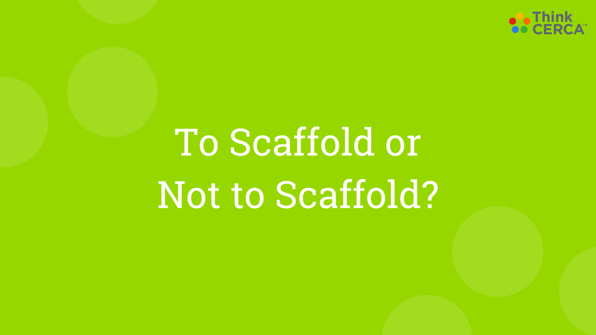
To Scaffold or Not to Scaffold?

ThinkCERCA educators frequently asked this question:
“Can we remove scaffolds from ThinkCERCA lessons in the platform?”
Hopefully this blogpost will provide some context as to why we’ve disabled teachers from being able to turn those scaffolds off.
1. Audio support, sentence stems, and other scaffolds are integrated into the platform as part of our research-based approach to literacy instruction.
By reducing cognitive load through chunking and tech-enabled tools, we’re clearing the way for students to focus on the learning task at hand. It’s hard-coded into our approach, both literally and figuratively, and if a student doesn’t want to use it, because they find it tedious or unhelpful, they can simply ignore it!
2. If students are using the scaffolds, they probably feel they need to.
The procedural and tech-enabled scaffolds built into the ThinkCERCA platform are used by the students who truly benefit from the support they provide. While scaffolding features are essential in building a sense of self-efficacy for students who may require the additional assistance, students who don’t need them simply don’t use them.
Since these scaffolds don’t exist outside of the ThinkCERCA platform, students have plenty of practice without the scaffolds and likely have better experiences independently after using our supports to strengthen reading and writing skills.
3. Scaffolds keep the momentum going and allow students to focus on the heart of the learning task at hand.
With scaffolding built directly into the platform, we eliminate the barrier for students to use their voice to ask for help. .
Additionally, and most importantly, the scaffolds act as a mechanism for bridging persistent learning gaps. These tools allow learners to stay up-to-date on class material while building important skill sets to gain independence in their learning, making headway on closing learning gaps. Just as a translation tool in a browser, or a voice to text tool on a smart phone allows students to do things that they can’t easily do on their own, the ThinkCERCA scaffolds are tools that build habits and skills that lead to student success and learning growth.
ThinkCERCA educator Kelly McCurdy of Vancouver Public Schools in Washington State conveys the importance and best practices of scaffolding in the context of supporting English language learners and students with reservations about writing.
Listen to Kelly’s comments in our Social Justice Webinar:
4. Scaffolds can add value, even if they aren’t absolutely necessary for success.
There is value in scaffolds, even if a specific need doesn’t exist. Listening to a fluent reading of a powerful text is an enriching experience that supports more than just comprehension. A read-aloud can unlock the pleasure of a text in a new way for a student. Also, a student who is experienced in making counterarguments might not need a sentence stem to form their counterargument, but using the sentence stem to kick-start thinking is still helpful and enriching.
Here are our main takeaways:
- ThinkCERCA’s scaffolds are rooted in research
- Scaffolding is used by students who need it to maximize their learning
- Scaffolds keep the momentum going so learners aren’t stuck, building confidence and empowering students when they otherwise may feel discouraged

